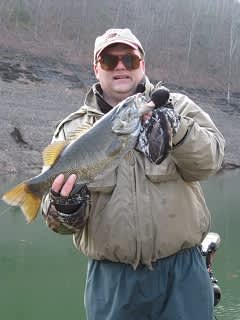Arctic Winds Bring Float and Fly Time to Kentucky

The late Charlie Nuckols owned a tackle shop and lure company in east Tennessee, near South Holston Lake. Winter crappie anglers who fished small marabou jigs deep under bobbers complained to him about big smallmouth breaking off their rigs all of the time.
This got Nuckols thinking. He, along with his brother Eddie, began experimenting with suspending small jigs, eventually settling on those tied with craft hair or duck feathers. They fished these jigs 8-to12-feet deep, suspended under bobbers cast on long, soft spinning rods along bluffs and deep points on South Holston Lake. They began to regularly catch smallmouth bass over four pounds on this new system. Word began to spread to other smallmouth lakes in the region, notably Dale Hollow Lake.
I read and heard about the technique and tried it a few times without success, using makeshift equipment ill suited to the task and fishing it with little passion. I wanted to get back to swimming a small bucktail jig just above bottom or casting live shiners – my preferred winter baits. After some friends starting having good success with the float and fly, I relented and bought the correct equipment and determined I would fish it until I caught a smallmouth.
It didn’t take long. Within my first dozen casts of fishing the float and fly correctly, I caught a 19-inch smallmouth that weighed right at four pounds. I’ve been hooked since. Now that arctic winds chilled the air and water in Kentucky over the last week, it is time to try this effective technique. The colder the water, the better the float and fly works.
The float and fly imitates what happens to baitfish such as shad in reservoirs in mid-winter. “Once the water temperatures drop below 50 degrees, shad don’t feel too good,” said Gerry Buynak, assistant director of fisheries for the Kentucky Department of Fish and Wildlife Resources. “The cold water makes shad distressed and they flip around, twitch and swim in circles. The little jig imitates exactly what is happening to them.”
Smallmouth bass suspend under schools of baitfish and pick off the ones twitching as they fight to survive winter’s cold. Nature programmed smallmouth bass through the millennia to take advantage of easy feeding opportunities in winter. Female bass, especially, need winter nutrition to fuel egg development for spring spawning.
The next two months are the best time of year to employ the technique in the lower ends of Lake Cumberland, Dale Hollow Lake, Laurel River Lake, Green River Lake, Barren River Lake and the small mountain impoundments such as Cranks Creek (Herb Smith) Lake or Cannon Creek Lake.
When I got serious, I bought an 8 -foot rod from a top of the line manufacturer, attached a decent reel and bought a mixture of 1/16-ounce jigs made from duck feathers, craft hair or a mixture of both. I spooled on 4-pound test line and got busy. It isn’t necessary to spend a ton on the rod as manufacturers now offer affordable spinning rods from 8-to 11-feet long.
A 1/16-ounce craft hair fly in combinations of light blue, chartreuse, white, blue or silver work well. I drop down to 1/32-ounce flies on bright, shimmering days after a cold front.
Duck feather flies with stands of red or chartreuse craft tied into them produce best when the water temperatures fall below 47 degrees. Some anglers apply a petroleum jelly based scent called “dope” to their flies.
I trim my craft hair flies to match the bend of the hook and apply liberal amounts of dope. This gives the fly a slim profile and no action, which turns on lethargic smallmouths. If the water is a little stained, I apply dope only to the head of the fly to let the craft hair breathe and undulate so the smallmouths can find it easier. I only apply dope to the head of duck feather flies.
Set the bobber about 9 feet above the fly to start and adjust shallower or deeper as needed. Some anglers use a main line of 8-pound braided line running to a small brass three-way swivel with a leader of 4-pound fluorocarbon attached to one of the loops and clipping a small 7/8-inch pear-shaped plastic bobber to the other. Others simply tie a fly to a 4-pound main line of clear or green fluorocarbon or monofilament line and attach the bobber to the line as they are more comfortable with one knot than three. Both catch trophy smallmouths.
Cast the fly to main lake and secondary points or rock bluffs. Allow the bobber to ride up and down with the waves, letting nature impart action on the fly. After a time, reel in about five feet and repeat. In calm water, make the bobber wink at you by shaking the rod tip up and down to give the fly action.
Set your drag lightly. Watch the bobber intently. Big smallmouth bass often barely take the bobber under after they inhale the fly and don’t move. Trophy smallmouth bass coming from deeper water often engulf the fly and move shallower, causing the bobber to flop over on its side. Set the hook immediately if this happens.
Tackle shops around Lake Cumberland or Dale Hollow Lake carry the correct rods, flies, dope and other float and fly accessories. An internet search reveals dealers that carry this equipment as well.
Burn away the winter blues with a slipping drag from a huge smallmouth bass that just took your fly. The float and fly is similar to the bobber fishing you did as a kid, but instead of bluegill hitting, it is a 21-inch smallmouth.

